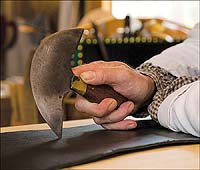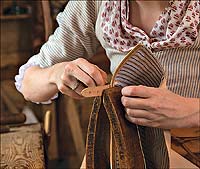Page content
A Battalion of Skills
Laborers whose trades helped the military, called artificers, navigated a ‘messy’ supply system
by Nicole Trifone
Photography by Dave Doody
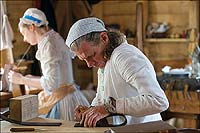
Jay Howlett, working here with intern Emma Cross, takes pride in being able to stitch almost any kind of fabric.
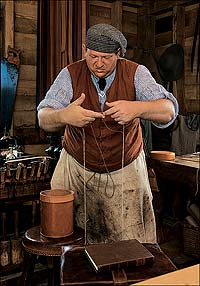
They, along with a second intern, Jan Tilley (above), demonstrate the intricate handwork necessary for leather goods.
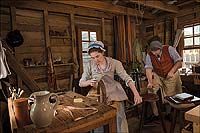
The trade is practiced at a shop housed in James Anderson's Public Armoury in the summer and at the Magazine in the winter.
With a milliner, saddler and breeches maker all under one roof, the artificer workshop in Colonial Williamsburg’s Historic Area can handle just about any leather goods project the Colonial army might have needed in its fight for independence.
Whether it’s a saddlebag used to carry correspondence between camps, new bayonet belts for a company of soldiers or a basic shoe repair for a private, the team of leather-goods specialists who interpret a government-run artificer shop can take on the job.
The ultimate goal: Provide functional, not fashionable, products in support of the military effort. The shop is responsible for outfitting the soldiers in Colonial Williamsburg’s military programs with leather items needed for their uniforms. With no front window to lure shoppers and few products hanging on display, the shop is very much a workspace for the three tradespeople — Jay Howlett and his two donor-funded interns, Emma Cross and Jan Tilley — who also receive support from shoemaker Valentine Povinelli on a part-time basis.
“The one common denominator is we all push a needle,” said Howlett, who oversees Colonial Williamsburg’s artificer shop. “Between us, I don’t think there’s a fiber or fabric or material that one of us doesn’t know how to stitch.”
Though Howlett’s shop focuses on leather goods, an artificer in the 18th century was defined as any skilled laborer whose work supported the military — a term that evolved from the even broader “skilled laborer” definition that had no specific attachment to the military and has since largely disappeared in the U.S.
Colonial Williamsburg’s artificer shop is a representation of one of the many government-run shops that operated during the Revolutionary War.
Artificers could be found in government-run or commercial shops. They could be enlisted or contracted. They could travel with a regiment or be fixed in one place. They could represent any trade that in some way supported the military, from blacksmiths to wheelwrights to tailors. They could be men, women or children as long as their labor helped to supply the military.
“If you’re going to keep an army in the field all the time, you’re going to have to keep them fed, keep them dressed, keep them housed, keep them clean, keep them maintained,” said Howlett, whose own shop reflects diversity in specialties and gender. “All of a sudden, that army is going to need another army to support them. That other army is the artificers — skilled laborers, men or women, who can get the job done.”
A multitude of trades from both the military and civilian world were called upon to provide for the army, but the supply system was “messy,” especially early in the war, said Cathy Hellier, a Colonial Williamsburg historian. Though the Continental Congress established a Quartermaster Department in June 1775 to oversee the supply system for the Continental Army, it struggled to establish regulations on the transportation of goods and conflicts of interest.
“Independence was like young people going out on their own, and they suddenly realize how much structure their parents had provided. Now they have to do things all on their own and sometimes they don’t even know which questions to ask,” said Hellier, who serves as a liaison to the military programs. “The Colonies begin to regulate the supply system more as the war goes on to make things less messy, but the supply system remains messy.”
In an attempt to provide troops with necessary materials before the Colonies even declared independence, Virginia’s government opened several workshops for various trades. Over the years, the state opened the “Public Taylors Shop” in Williamsburg; a shoe manufactory and tanyard in Chesterfield County; small-arms manufacturers in Fredericksburg and in Berkeley and Loudoun counties; an ironworks shop in Falmouth; and a foundry outside Richmond.
In the fall of 1775, the state opened the Public Store at Williamsburg, which operated as a supply depot that collected both domestic and foreign goods throughout the war. Trade shops — both commercial and state-run — would often receive materials from the Public Store to fulfill the military’s needs, such as tailors commissioned to fashion both uniforms and tents or shoemakers asked to produce shoes.
Without the military’s business, tradespeople would have had a difficult time making ends meet during the war. Not only did materials and supplies become less accessible at times, but the customer base shrank: The war effort became the principal economic pursuit for tradespeople.
“People simply aren’t buying luxury goods during the war,” Howlett said. “Nobody’s got an awful lot of extra money. Because a tailor isn’t having people come in to buy new suits, that tailor takes on a government contract to make tents because, hey, money is money.”
The unreliable transportation of goods became one of the major complications for both production and distribution during the war period. Artificers found they had to establish new trade networks because the British firms that supplied them for generations were now closed to them.
“The big change is not that the Colonies had to switch from imported goods to domestic production. We’re still using imported goods just as much, but where we’re getting them from all has to change,” said Howlett, who noted the Colonies relied heavily on trade with the French and Dutch.
Privateers and blockades stood as obstacles to the transportation of goods throughout the war, though the intensity of those obstacles often shifted with the theater of war. Land transportation also had major drawbacks: treacherous roads, unpredictable weather and few options for teamsters willing to take on the work. The Continental Army’s shortages often had little to do with whether products or materials were available.
“We don’t have enough boats, we don’t have enough teamsters, we don’t have enough wagons,” Howlett said. “So there might be 10,000 pairs of shoes sitting in Boston, and the Army in Hudson Valley, New York, is barefooted because there was no way to transport them.”
The story of tradespeople, as artificers, during the Revolutionary War is told to guests who stop by Howlett’s shop in the Historic Area. He and his two interns are quick to point to the blacksmith workshop next door as another example of an artificer or the tailor shop down the street as a probable government contractor.
Throughout the summer, the shop helped guests experience what a day in the life of a leather-goods worker might have been like with a new program that allowed them to produce a belt or wallet themselves. Guests heard about the leather goods his shop produces and how those goods would have contributed to the military effort, along with the obstacles artificers may have encountered or the benefits of being one of the relatively few skilled laborers in the agriculturally focused Virginia.
“I hope people who visit really get the sense of how large a problem supplying the Army of Independence really was, and how incredible it is that we were actually able to be successful,” Howlett said.

